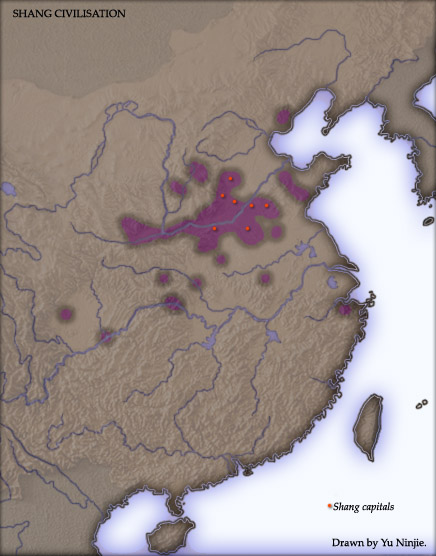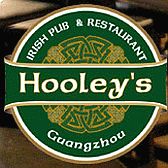|
|
| Chinese
History |
Shang Dynasty
|
|
Shang Dynasty (1600
– 1046 BC; alt Date : 1766)
Often
regarded as the First proper Chinese Dynasty, the
Shang ruled a large area that comprised the Eastern
and Middle reaches of the Yellow River.

Kindly reproduced from Wikipedia ref:
http://en.wikipedia.org/wiki/Shang_Dynasty
Courtesy of Yu Ninjie
In 1600 BC, the Xia were overthrown by King Tang
of the Shang, and a new Dynasty was created.
From the diagram above, you will note that there
are areas of settlement and Dynastic control in other
parts of China, and especially along the Yangtze River.
It is known that the Shang built walled cities made
of traditional compacted earth, often 27 feet high
(8.2 M), and I would urge to to view the map above
as representing strongholds and administrative centres
that withstood the test of time. By inference, this
also means that much of the land in between was controlled
by the Shang, at least so far as safe-passage is concerned.
This also indicates Trade routes, especially via major
(Wide) rivers
The Shang spent long periods fighting off invaders,
and especially those from the North – something
that is a common perception for most Chinese peoples.
By contrast, they did have very good relations with
the Northern Yan culture, which was later integrated
into the following Zhou Dynasty
The Shang Dynasty was noted for introducing the first
recorded writing system as we would understand it.
This implies advanced government and burocrasy also.
These are most notably found on Bronze wares, indicating
that writing had been used in other forms for a period
of time. However, most Shang script was written on
‘Oracle Bones’.
Like their predecessors, the Shang had many Capital
cities; which leads me to suggest that given they
used a Royal Family model, then the Capital city moved
to where the Son, Uncle, or Nephew was in overall
control. I am sure there was much politicking and
succession intrigue – just as Northern Europe
experienced 2, 000 years later
Historians often divide the Shang into two parts.
The first is concerned with warring factions, whilst
the second from Circa 1350 BC is called the Golden
Age. This saw a flourishing culture and gave rise
to many new or improved Arts. This period is also
synonymous with Yin culture
The Shang lost dominion following The Battle of Muye
to The Zhou, who could be considered as a vassal and
subordinate Western state of Shang.
Factfile:
1. Based on the Middle reaches of The Yellow River
in Henan Province
2. Often referred to as The Yin Dynasty (Especially
by modern people from Korea and Japan
3. Period of power (Not sovereignty) 1766 to 1046
BC
4. Capital City: Yinwu near modern Zhengzhou in Henan
Province
a) Alternatives: 6 Capitals (From many): Yin (Main
Capital), Yanshi (Xia Dynasty also), Anyang (May have
been a different culture entirely). They also called
their Capital City: ‘Shang’, which may
be a real and different place?
5. Common artifacts: Bronze, Jade, Bone, Stone, Oracle
Bones, and Ceramics
6. Advanced conceptual writing system
a) Turtle shells carbon-dated to 1500 BC show ancient
Chinese characters
7. Writing indicates common usage of thinking such
as: politics, economy, culture, religion, geography,
astronomy, calendar, art, and medicine. Tomb excavations
reveal that women were sometimes great military leaders.
8. Look again at the map above, and conclude that
this is a local area within what is now Modern China.
Other cultures to the South, North, East, and West
were also doing similar things – except we do
not know about them yet. Or do we?
9. Mainly ‘Closed’ to outside influences
and International Trade. There is evidence of International
Trade, but in general the Shang tended to avoid contact
with outside powers; excepting Fujian Province to
the South, Taiwan, and other pre-dynastic country-states
nearby such as Korea and Japan
10. Politics: The Shang were mainly not a great political
force, but owed their supremacy to military superiority.
They overthrew the Xia by use of chariots, archers,
and high-grade bronze weaponry, such as their favoured
short sword and a form of spear. They relied heavily
on commoners conscripted as foot-soldiers, and governed
by Decree to local Administrators (Warlords). Sounds
a little reminiscent of the later the Roman Empire
to me, but what do I know?
Note:
It would be typical for any Chinese culture to have
long periods of stability and harmony, interspersed
with wars and political intrigue. Culture and Arts
tend to advance during safe periods, whilst weaponry
and logistics advance during times of war.
The Chinese understood that one Empire would be replaced
by another over time (A bit like Darwin and his theory
‘Survival of the Fittest’). What you should
consider, is that some of these Empires may have been
around at the same time. Some of the Pretenders to
the Throne were looking for their best chance of power.
They were contemporaries. They over-lapped in terms
of ‘Rise and Fall’.
Reference Points:
1. Perception: Being the Geographical Centre of China,
and therefore ‘The World’, (Yellow River,
Yangtze River; Shaanxi and Henan Provinces) |
|
This
information is as supplied by Wikipedia, as dated March
2009 or later, and/or other reliable sources.
Maps (Unless stated otherwise)
are provided in association with Thomas Lessman
Web: www.worldhistorymaps.info
Disclaimer:
Please check this information yourself as it may alter
without notice, and whilst we try our best to ensure
it is correct, please do not hold us responsible for
any errors - this is intended as a simple guide only |
|
| Search
this Website |
|
|
| Our
Friends |
Excellent
& Free Online Chinese Language Portal

Thousands of free print-friendly Chinese reference sheets,
tests and revision aids.
Easy Learning format &
Listen to Spoken Words |

Professional
Visa Services
Company
Formation Packages
.
|

British Foreign Office
Resource and Advice for Travellers Worldwide |

Chinese Embassy in UK
Information About China
International Relations
Visa & Consular |

UK Embassy in China
Information About UK
International Relations
Visa & Consular |

|
Excel
Education |
Languages Courses
Study Abroad
Employability
Summer Camps
Information for Teachers |
|

Excellent and relaxing base to
explore this most beautiful of regions in all China! |
Down The Road.org
How We Traded Our Ordinary Lives For a Global Bicycle Touring Adventure

See
Us in China |

Empowering Underprivileged Children
& Their Communities = Worldwide |
 |

Based in Shangri-la,
Yunnan
Province
Dedicated to Exploring Remote Areas of China
Committed to Nature Conservation and Preserving Ethnic
Cultures & Traditions
|

Based in Xi'an,
China's Premiere Travel Agency and International Travel
Community -
Committed to providing:
Best travel deals & current information for all
International Travellers |

Pearl Dragon
Vast
Online Trading and Information Resource
Link goes to Chinese Tourism and Galleries Section |
|